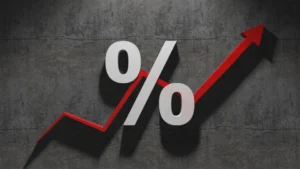Table of contents
ToggleIntroduction
Why can a single decision by a central bank shake the markets, slow down growth, or trigger a financial crisis? The answer lies in two words: interest rates. As a true compass of the global economy, their fluctuations directly affect businesses, households, and governments.
Interest rates therefore play a fundamental role in the global economy. Largely set by central banks, they directly influence the cost of credit, savings, investment, and, more broadly, economic growth. A simple change in these rates can cause ripple effects on companies, households, and financial markets.
In recent years, rising inflation and the monetary policies of major powers have placed interest rates at the heart of economic debates. In 2023, the US Federal Reserve and the European Central Bank raised their rates to unprecedented levels since the 2008 crisis, leading to a credit slowdown, market tensions, and investor uncertainty. But how exactly do these decisions impact the global economy?
We will first look at how interest rates work and their role in the economy, before analyzing their influence on consumption, investment, and financial markets. Finally, we will examine their effects in a globalized context and discuss future trends.
1. The Mechanics of Interest Rates
A. How Interest Rates Work
An interest rate represents the cost of borrowing for a borrower and the return on savings for a lender. It is expressed as a percentage and varies based on several factors, such as the loan duration, risk level, or the prevailing monetary policy.
Several types of interest rates can be distinguished:
Policy rates, set by central banks, determine the cost at which commercial banks refinance themselves. They influence all rates in the economy.
Interbank market rates, which govern loans between banks.
Bond yields, reflecting the return required by investors to lend to governments or companies on financial markets.
Lending rates for households and businesses, such as mortgage or consumer loan rates.
Real interest rate, which is the nominal rate adjusted for inflation, indicating the true cost of money for economic agents.
B. The Role of Central Banks
The primary drivers of rate fluctuations are central banks. Institutions like the Federal Reserve (Fed), the European Central Bank (ECB), or the Bank of England are tasked with ensuring economic and monetary stability. To this end, they adjust policy rates to influence the money supply and inflation.
In times of low growth or crisis, central banks lower rates to stimulate borrowing and investment, thus boosting economic activity.
Conversely, in times of high inflation, they raise rates to make credit more expensive, reduce consumption, and curb price increases.
These decisions have a major impact on financial markets, exchange rates, and countries’ economic competitiveness.
C. Factors Influencing Interest Rates
Interest rates are not fixed and evolve based on various economic and financial elements:
Inflation: Rising inflation prompts central banks to raise rates to preserve purchasing power and prevent economic overheating.
Economic growth: During expansion periods, rates tend to rise to avoid speculative bubbles, while in recessions, they are lowered to revive activity.
Government debt levels: Highly indebted countries may see their rates rise as investors demand a higher risk premium.
Decisions by major central banks: Monetary policies of economic powers influence global rates, especially in emerging markets reliant on foreign capital.
Financial or geopolitical crises: In uncertain times, interest rates may be adjusted to stabilize the economy and reassure markets.
Thus, interest rates are not mere abstract figures but strategic tools with a direct impact on the global economy. Their fluctuations shape economic and financial dynamics, leading us to analyze their concrete effects in the next section.
2. The Impact of Interest Rate Fluctuations on the Economy
A. Effect on Consumption and Investment
Interest rates directly affect the cost of borrowing and, consequently, household consumption and business investment.
For households, when rates are low, “everything is fine”: mortgages and consumer loans become more accessible, encouraging purchases of homes, cars, or appliances. Conversely, a rate increase raises credit costs, curbing spending and potentially slowing down the real estate market.
For businesses, low rates are also good news, as they foster productive investments to finance new projects, hire staff, and innovate. However, rising rates mechanically increase capital costs, limiting investments and slowing growth.
In summary, lower rates stimulate demand and economic growth, while higher rates tend to slow activity by restricting borrowing capacity.
B. Influence on Financial Markets
Interest rate fluctuations also have a major impact on financial markets by altering asset returns and capital flows.
Effect on equities: Low interest rates make bonds less attractive, pushing investors towards equities, which boosts stock indices. Conversely, rising rates increase capital costs for businesses, which can trigger stock market corrections.
Effect on bonds: Rising interest rates decrease bond values, as new bonds offer higher returns. This can create tensions in bond markets and make financing more expensive.
Effect on exchange rates: A country that raises its rates generally attracts foreign capital seeking higher returns, leading to currency appreciation. Conversely, low rates make the currency less attractive, favoring depreciation and boosting exports.
C. Consequences on Economic Growth and Employment
Interest rate trends influence economic growth by affecting access to financing and investment profitability.
During periods of low rates, favorable credit conditions support consumption, investment, and job creation, thereby stimulating economic growth. However, if rates remain too low for too long, they can create speculative bubbles and over-indebtedness, increasing the risk of financial crises.
Conversely, rate hikes can slow the economy by making credit more expensive, limiting household spending and business investments. Economic slowdown may then translate into lower demand, reduced hiring, and rising unemployment.
Central banks must therefore strike a balance between keeping rates low enough to support economic activity and high enough to prevent inflation and financial imbalances.
3. Interest Rates in a Globalized Economic Context
A. Interest Rates and Global Financial Stability
Interest rate fluctuations play a key role in international financial stability.
Risk of financial crises: Persistently low interest rates can lead to excessive debt accumulation and speculative bubbles, as seen during the 2008 subprime crisis. Conversely, a sudden rate hike can trigger market collapses and a cascade of bankruptcies.
Impact on sovereign and corporate debt: Highly indebted countries, especially emerging economies, are particularly vulnerable to rising rates. Higher rates increase debt refinancing costs, potentially leading to budgetary difficulties and sovereign debt crises.
Capital flows and monetary instability: Investors constantly seek to maximize returns. When interest rates rise in the US or Europe, capital often leaves emerging markets to reposition in these safer, more profitable areas. This can cause sharp depreciations of local currencies and financial instability.
B. Diverging Monetary Policies Among Major Powers
Major central banks—Federal Reserve, ECB, Bank of Japan, Bank of England, etc.—adopt different monetary policies depending on their own economic priorities.
The US and the Fed’s domino effect: The Federal Reserve plays a central role in the global economy. When the Fed raises rates, the dollar strengthens, increasing the cost of dollar-denominated debt in emerging markets and often slowing global economic growth.
Europe and the ECB: The ECB must navigate the diverse economies within the eurozone. A too-strict monetary policy can hurt southern countries (Italy, Spain, Greece), while an overly lax policy can fuel inflation in northern countries (Germany, Netherlands).
Japan’s ultra-low rates policy: For decades, the Bank of Japan has maintained extremely low rates to support its economy, impacting global financial flows and the competitiveness of Japanese companies.
Emerging economies under pressure: Countries like Brazil, India, or Indonesia often need to adjust their own rates in response to decisions by major central banks, to prevent currency depreciation and capital flight.
These monetary divergences highlight how a rate decision by a major power can have ripple effects worldwide.
C. What Are the Prospects for Future Interest Rates?
The evolution of interest rates in the coming years will depend on several major economic and geopolitical trends.
Inflation and global growth are critical indicators for the future of short-term interest rates. If inflation remains high, central banks will be forced to maintain high rates, potentially slowing growth. A concrete example is Trump’s tariff policy in the US. The Federal Reserve, which had begun cutting rates to revive the economy after inflation eased, had to reverse its plans. This stimulus policy was abruptly halted due to uncertainty over growth and inflation trends, showing the importance of these indicators in central bank decision-making.
Additionally, the growing burden of public debt also plays a significant role. Many countries, particularly in Europe and the US, have record levels of debt. A sharp rise in rates could make this debt unsustainable and trigger budgetary crises.
Towards an Era of Higher Rates?
After more than a decade of ultra-low rates, some experts believe we have entered a new economic cycle where rates will remain structurally higher. This trend could reshape global finance, with impacts on real estate markets, investments, and sovereign debt.
Conclusion
Interest rates are a central lever of the global economy, influencing household consumption, corporate investment strategies, and financial market dynamics. Central banks manage them to maintain a balance between economic growth and price stability, but this comes with major challenges, especially in a context of high inflation and rising public debt.
In a globalized world, interest rate fluctuations go far beyond national borders: they trigger chain reactions on an international scale, affecting capital flows, exchange rates, and the financial health of emerging economies. The recent rate hikes by the Federal Reserve and the ECB have illustrated how much these decisions can impact the entire global economy, from currency values to recession risks.
The future of interest rates will depend on many factors, including the trajectory of inflation, economic growth, and geopolitical tensions. While some experts predict an era of persistently higher rates, others foresee renewed monetary easing in response to upcoming economic challenges. In any case, their role will remain crucial in shaping global economic trends over the coming decades.
Thus, understanding the mechanisms and impacts of interest rates is essential to anticipate global economic trends and make informed financial decisions, whether as an investor, business leader, or consumer.





